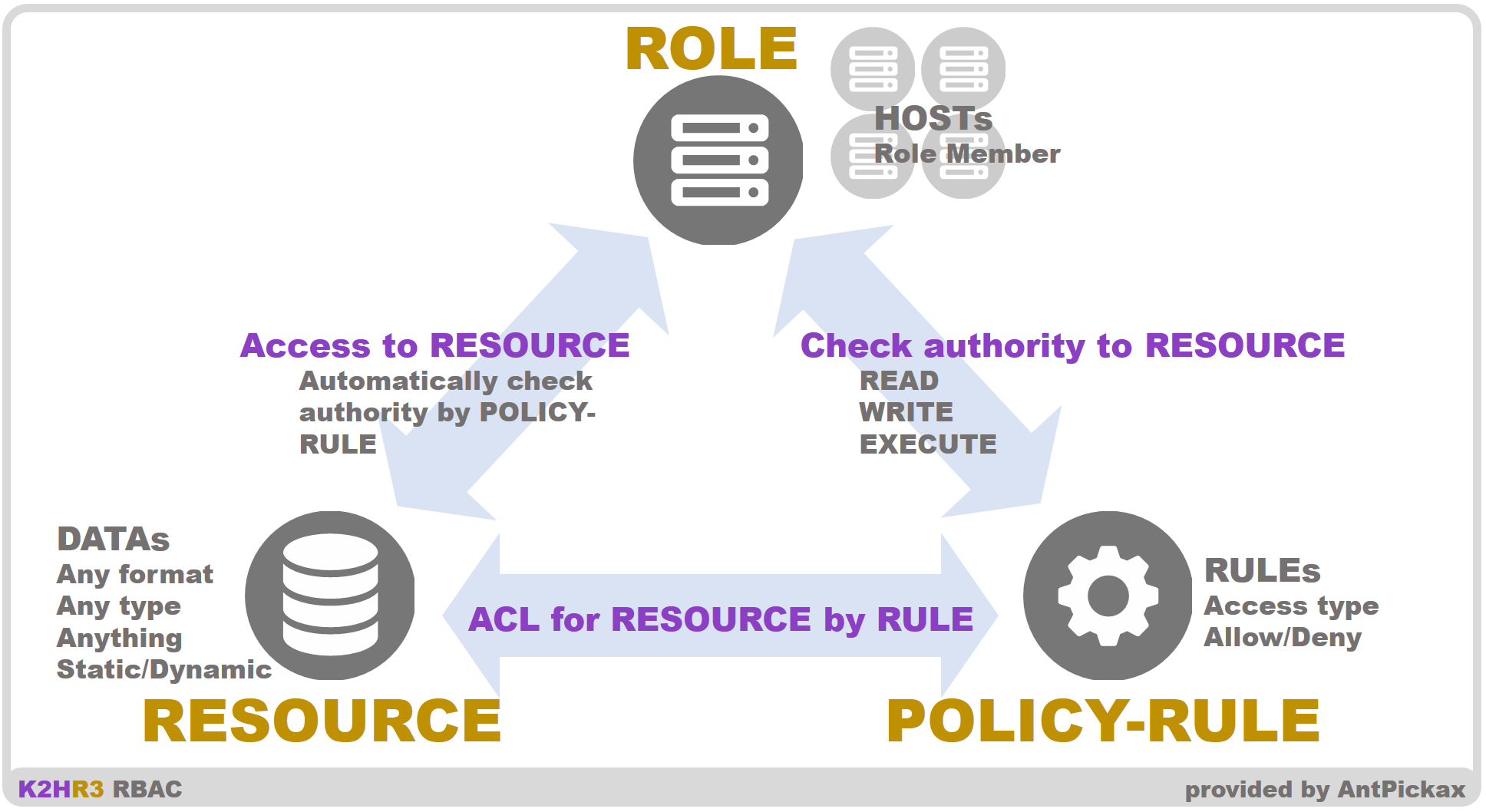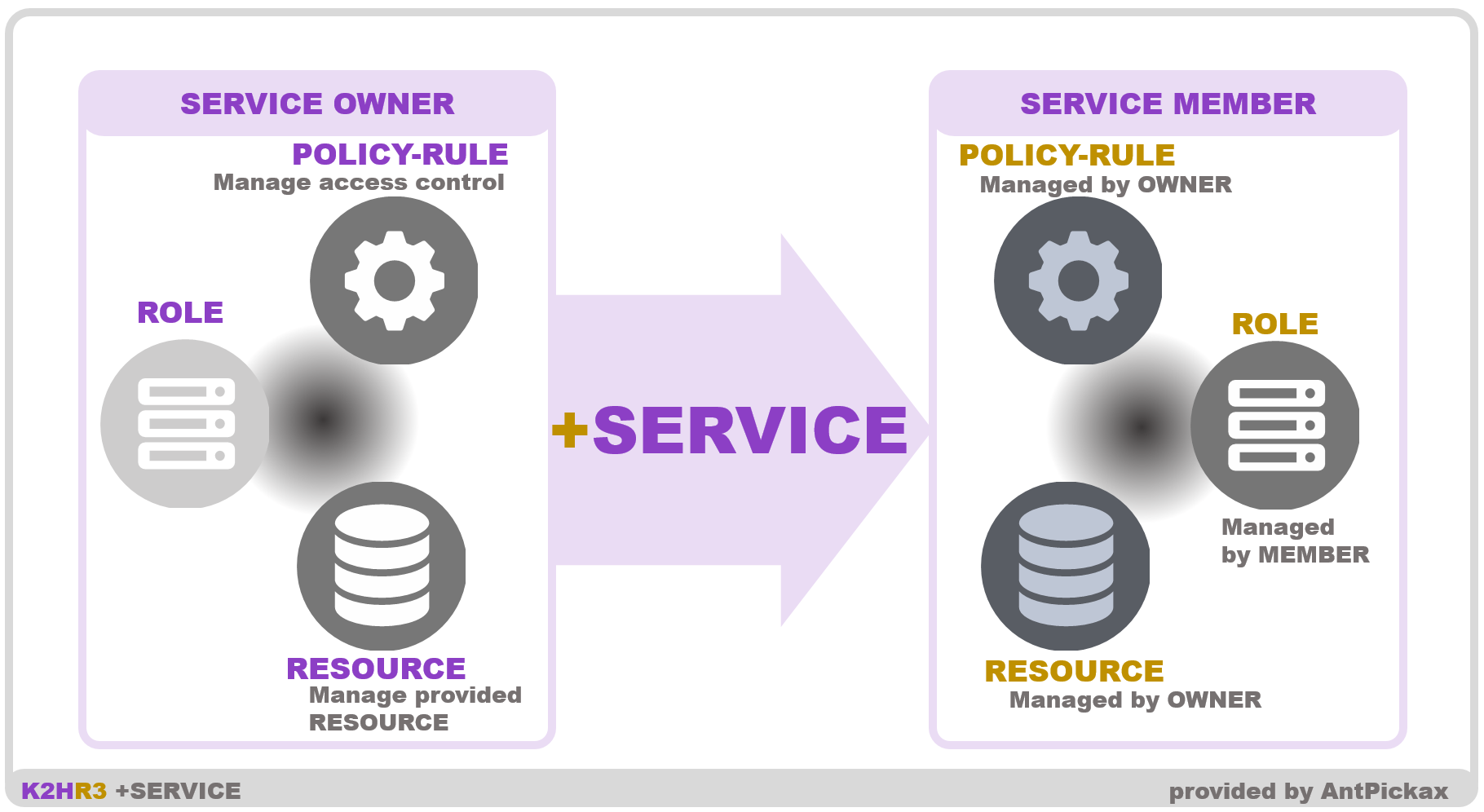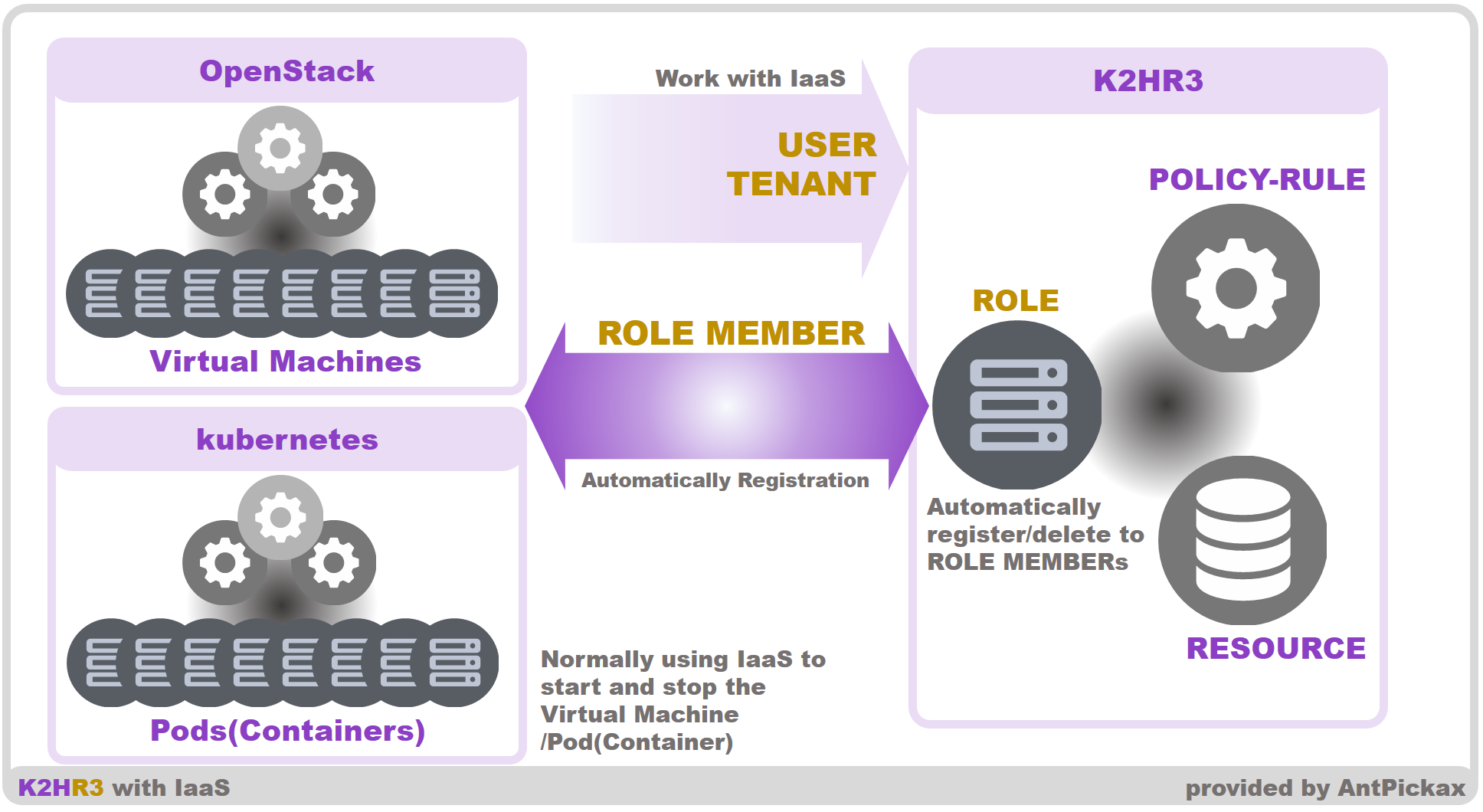Feature
K2HR3 (K2Hdkc based Resource and Roles and policy Rules) is one of extended RBAC (Role Based Access Control) system.
This section explains the features of the RBAC system and unique functions provided by the K2HR3 system.
RBAC(Role Based Access Control)
The K2HR3 system controls access to RESOURCE as a RBAC system.
The K2HR3 system defines “WHO(ROLE) access to WHAT(RESOURCE) controlled by HOW(POLICY-RULE)” and provides a function to make it easier to manage this.
TENANT
TENANT is a group of users who use the K2HR3 system.
The K2HR3 system is designed to work with IaaS(Infrastructure as a Service).
K2HR3 system can work together IaaS like OpenStack and kubernetes.
If you use OpenStack, K2HR3’s TENANT matches OpenStack tenant(or project).
In the case of kubernetes, it is necessary to link with the user management system used in the kubernetes system.
You can can also create your own TENANT that is not affected by IaaS one.
This is called a K2HR3 Cluster Local Tenant within a K2HR3 cluster and works similarly to an IaaS based TENANT.
Thus you can create and manage your own TENANT independently of the TENANT based IaaS.
The ROLE, RESOURCE, POLICY-RULE, and SERVICE described below are data belonging to the TENANT.
A user of K2HR3 system belongs to some TENANT and can edit the data of those TENANT.
ROLE
ROLE of the K2HR3 system means WHO described above.
Then ROLE is a grouping of sets that access RESOURCE(WHAT).
ROLE is a group that accesses RESOURCE, and the user registers host information(IP address etc.) in this group and permits access to RESOURCE.
And the users can also include other ROLEs in ROLE.
In this way, the user can create a minimum unit ROLE according to the role and define a large unit ROLE containing these ROLEs.
And you can define flexible ROLE according to accessed RESOURCE by using this ROLE registration function.
The K2HR3 system automatically registers/deletes members(IP address, etc) to ROLE by working with IaaS(OpenStack, kubernetes).
K2HR3 user can register automatically as ROLE member by simply starting a Virtual Machine or Container with IaaS already in use.
RESOURCE
RESOURCE of the K2HR3 system means WHAT described above.
The users can register any data as RESOURCE in the K2HR3 system.
Users can register data of any format in RESOURCE without relying on formats such as strings and binaries.
Also, users can register as static and dynamic data(RESOURCE). If dynamic data is registered in RESOURCE, the user can read it as data to be confirmed when accessing it.
The user can read out the result of combining multiple RESOURCE.
RESOURCE can be defined and registered in minimum units, and a large unit RESOURCE containing them can be defined and registered.
This allows users to divide and manage complex RESOURCE data into simple RESOURCEs, and the user can create any data set.
K2HR3 system provides the K2HR3 Template Engine to enable users to use dynamic RESOURCE.
POLICY-RULE
POLICY-RULE of the K2HR3 system means HOW described above.
POLICY-RULE defines how to access RESOURCE by ROLE.
The K2HR3 system defines the following POLICY-RULE value.
The user combines these values and registers POLICY-RULE.
- READ(readable)
- WRITE(writable)
- EXECUTE(executable) reserved
The user registers target RESOURCE to which the access type defined by POLICY-RULE is applied in POLICY-RULE.
By registering POLICY-RULE in ROLE, the access type of POLICY-RULE is applied when accessing the target RESOURCE from ROLE.
Schematic block diagram

+SERVICE
In addition to RBAC function, K2HR3 provides +SERVICE function that works with it.
This +SERVICE function is used on the RBAC function, supports the cooperation between the K2HR3 user’s system and service provider and user, and helps the operation of it.
Background
When providing a system or service as a backend to its users, the backend provider needs to control the user’s access to those systems.
The provider may also construct systems and functions for this access control.
This access control system requires functions such as provider, user, access type, authorization setting management of those, and also requires administrative functions to grant and revoke privileges between providers and users.
In addition, each time a provider’s system is added, removed, or modified, both the provider and the user occur as operational costs.
The +SERVICE of K2HR3 provides these adjustments and settings at low cost for the system and service provider and users based on the RBAC function.
We believe that operating costs can be reduced by preparing the following conditions.
- The provider can manage the increase and decrease of the access side by the group.
- The provider can dynamically set the system and service provided on a group basis.
- The provider can decide the scope of the system and service to be used.
- Users can freely set the increase and decrease of the access source within the permitted group.
+SERVICE will use the RBAC function to link system/services providers and users.
Collaboration by +SERVICE
+SERVICE defines system service providers and users as OWNER and MEMBER respectively.
+SERVICE creates and uses data called SERVICE to support cooperation between OWNER and MEMBER.
+SERVICE is used as shown below.

- [ OWNER ] Create a SERVICE for the system/service OWNER provide.
- [ OWNER ] Register RESOURCE in SERVICE.
- [ OWNER ] Register TENANT of MEMBER that uses SERVICE.
- [ MEMBER ] Create ROLE as a group that uses provided system/service.
- [ MEMBER ] Check SERVICE registered as MEMBER in TENANT.
- [ MEMBER ] Register ROLE to collaborate SERVICE.
- [ MEMBER ] RESOURCE of SERVICE provided from OWNER is automatically set.
Operation work after OWNER’s SERVICE registration is only registering TENANT of MEMBER according to increase/decrease.
MEMBER who will start using existing SERVICE will be only register MEMBER’s TENANT by OWNER.
After that, MEMBER can freely increase/decrease ROLE associated with SERVICE and also increase/decrease host (based IP address/hostname) in this ROLE.
OWNER can freely change the RESOURCE being provided/registered to SERVICE MEMBER, regardless of whether SERVICE is used or not.
+SERVICE separates authority of OWNER and MEMBER so that each can manage data(RESOURCE/ROLE) freely within authority and reduce administrative cost.
Collaboration with IaaS
The K2HR3 system works in cooperation with IaaS(Infrastructure as a Service).
Currently, OpenStack and kubernetes are available as IaaS for K2HR3 system.
By collaborating with OpenStack and kubernetes, the K2HR3 system cooperates with instance startup/deletion of the OpenStack Virtual Machine or kubernetes Pod(Container) and automatically registers/deletes those as a member of ROLE.
The link between K2HR3 system and IaaS(OpenStack and kubernetes) is loosely coupled and can be installed without affecting the existing OpenStack and kubernetes system.
And you can use RBAC of K2HR3 system with the same OpenStack and kubernetes operation as before.

The user of the K2HR3 system only prepares ROLE before starting/creating the instance or Pod(container) by OpenStack or kubernetes.
And just by starting/creating an instance, the instance is automatically registered to that ROLE.
Even if you deleted an instance, it will be deleted automatically from ROLE just like when registering.